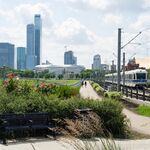dunno
Active Member
I don't like the implication here that a gondola is inherently a "tourist trap" and therefore not a legitimate form of transit, as if gondola's have never been used as a form of legitimate public transit. There are plenty of examples from around the world of them being used to move people quickly and efficiently around urban areas. These have taken off particularly in South America, and arose for similar reasons as the BRT networks of Guayaquil and others.
- La Paz, Bolivia
- Medellin, Colombia
- Cali, Colombia
etc have all adopted the system
A common factor between all of these is difficult and mountainous terrain, and cash strapped governments looking for ways to further connectivity in their cities. They have been particularly transformative in Medellin and La Paz. While Medellin may have considered tourism as an important part of their system construction, I don't see to many people rushing to La Paz, and yet they built it nonetheless.
Obviously an LRT connection is preferable, and I think it should happen eventually. But the fact of the matter is that to do that, there would either need to be a total rework or replacement for the High Level, which would inevitably be an expensive and arduous affair. For a more local example, just think about pretty much every ski resort, which uses this form of transit to efficiently move people around a mountain.
Urban Gondolas are a legitimate form of transit.
I never said that a gondola as a type of transportation is inherently a tourist trap. I know how it works in Medellin. I merely stated that the way it was to be set up, as something independent of the local public transportation system, would likely skew it in that direction (although @ChazYEG's post does clarify this a bit in a good way).
And also the High Level isn't the only place a crossing could be made. I shared a visual example of another pathway that could be used. There are probably at least 2 further crossing locations that could be pursued.




